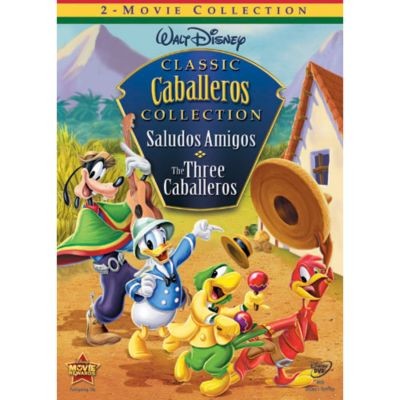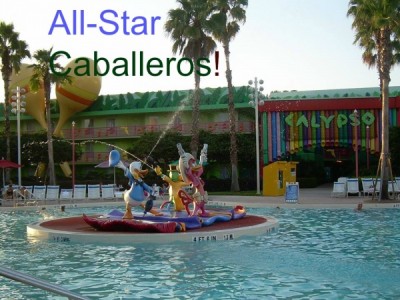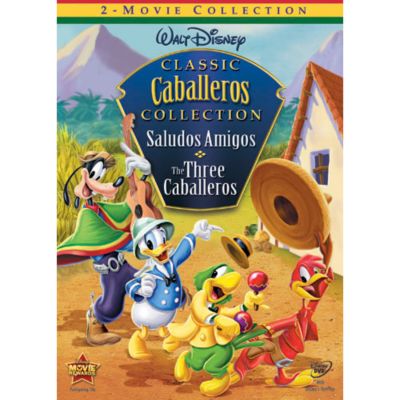
The Three Caballeros was released as the seventh full-length animated feature in Disney history on December 21, 1944. It was the second of six consecutive “package” films released by Disney and clocks in at seventy-two minutes.
Plot Summary
It is Friday the thirteenth. That means two things. First, it is the unluckiest day of the year, and, second, it is Donald Duck’s birthday. Where there is a birthday, there are presents, and said presents, from Latin American friends, shape the plot of The Three Caballeros.
Donald’s first present, a projector with film, prompts the movie’s first section, which is primarily composed of two animated shorts, “The Cold-Blooded Penguin” and “The Flying Gauchito.” The former short involves a penguin named Pablo attempting to escape the South Pole for a warmer climate, and the latter short features a young boy from Uruguay entering a flying donkey named Burrito in a horse race.
Donald’s second present is a surprise visit from his Brazilian friend Jose Carioca, who was introduced in Saludos Amigos (1942). Carioca sings a couple of songs to Donald before taking the Burbank-based Duck to his favorite locale in Brazil, Baia (Bahia). (1)
Donald’s final gift comes from Mexico and commences Panchito Pistoles’ role in the movie as the third caballero. Pistoles takes Donald and Carioca on a magic sarape ride to a whole new world…or something like that. The trio visits a dance floor in Veracruz, a beach in Acapulco, and the beautiful nighttime setting of Mexico City.
The movie concludes with several minutes of abstract animation and fireworks.
Politics
When people ponder Disney movies, thoughts of fantasy often come to mind. Many of Disney’s great films, after all, are based on fairy tales and fictional stories. The Three Caballeros is a departure from this norm, at least in concept.
In 1941, World War II was ongoing, and President Franklin D. Roosevelt was eager to apply his Good Neighbor Policy, which was meant to garner support for the United States in Latin America at the expense of Germany. Combined with an animators’ strike and financial turmoil at his studio, Walt Disney agreed to embark on a government-sponsored ten-week tour of South America and create corresponding films that would showcase the positive attributes of the region. (2)
Two films, Saludos Amigos and The Three Caballeros, resulted from the South American venture. The key difference between these films lies in their respective presentations. Whereas Saludos Amigos incorporated serious live-action descriptions of Latin American food, music, and other cultural and geographical aspects between animated shorts, The Three Caballeros intersperses the educational elements into the actual cartoon segments. Panchito Pistoles, for example, explains the history of the Mexican Flag to Donald Duck and Jose Carioca, and Pablo the penguin passes key geographical locales on his voyage to paradise. In other words, The Three Caballeros, unlike its predecessor, is not “transparent propaganda.” (3)
Changing Times
Nowadays, two elements of The Three Caballeros would probably prevent the movie from receiving a “G” rating. Jose Carioca smokes a cigar, and Donald has a rather creepy infatuation with the numerous women he encounters. The scene where Donald gazes into the face of Dora Luz in the Mexico City sky is especially bizarre.
Even at the time of the film’s release, Donald’s antics were critiqued. The Philadelphia Record, for example, questioned Donald’s behavior, saying, “Sex rears its pretty but definitely Freudian head…[as] our old friend Donald Duck becomes a very lusty drake as well as a girl-chaser to rival Harpo Marx.” (4)
Perseverance
As says an old adage, “If at first you don’t succeed, try, try again.”
In “The Cold-Blooded Penguin,” Pablo persists in his attempt to escape Antarctica for a warmer climate despite the ground falling out from under him during his early tries. The effort is rewarded when Pablo reaches, to quote narrator Sterling Holloway, “the isle of his dreams.” Ah, sunlight, bananas, and all the smoothies you can drink. This is the life.
Music
The Three Caballeros features a great soundtrack with a wide variety of songs pertaining to Latin America.
The film’s upbeat flagship tune, “The Three Caballeros,” voices the point behind the movie, namely to cement unity on the American continents. Just as Donald, Carioca, and Pistoles become friends, the United States wanted to earn the trust of Latin America. Pistoles finely sums up this goal with his line, “To fair or stormy weather, we stand close together like books on a shelf.”
“Baia” is a soothing, almost romantic, song, which is enhanced by incredible visuals of Bahia at either dawn or dusk.
Bahia also receives a more raucous song, “Have You Ever Been to Baía?” Carioca must be hard of hearing, because Donald tells him about a million times that he has not been to Bahia.
The film concludes with a love song, “You Belong to My Heart,” that Donald apparently likes. For better or worse, he sees beauty in the skies over Mexico City.
Additionally, the background music in “The Cold-Blooded Penguin” perfectly complements the on-screen action for that short. A vibration sensation is exuded when Pablo sets to rest on a rope, and the tune changes from suspenseful to peaceful as Pablo survives boat trouble and locates a hammock on the island.
Humor
Whereas slow and steady won the race in “The Tortoise and the Hare,” a strategy of stall and sprint works to perfection in “The Flying Gauchito.” Burrito’s speed is great enough to change the wardrobe of the spectators along the track!
The eccentric Aracuan Bird wreaks havoc by destroying a nest, stealing Carioca’s cigar, and redirecting train tracks.
Donald possesses great dance moves, likes to watch movies on his head, and cannot wait for Christmas.
The narrator describing South American birds inserts corny jokes to maintain Donald’s interest.
Pablo is a proficient bowler, though he needs to work on knocking down pins instead of fellow penguins. Oh well, at least he didn’t knock them down on purpose.
Animation
The animation quality of The Three Caballeros fluctuates among scenes but is generally excellent. In particular, I think the scene where Carioca sings “Baia” is one of the most beautifully-animated segments in Disney history. The twilight sky above Bahia is incredible to behold.
Significantly, The Three Caballeros marked the first time Disney mixed animated characters, Donald, Carioca, and Pistoles, with live actors in a single frame since the “Alice Comedies” of the 1920s. Thus, Donald dances among human actors, and the title characters mingle with the beachgoers at Acapulco. Such juxtaposition was thereafter used by Disney in Mary Poppins (1964), Bedknobs and Broomsticks (1971), and Pete’s Dragon (1977).
Abstract animation, involving bold colors and shapes, is utilized intermittently throughout the flick, most notably during the final ten minutes.
Prior to Pistoles’ grand entrance, an instrumental version of “The Three Caballeros” is played. The specific instrument used at the given moment in the song is abstractly animated into the background.
Questions
What became of the young guachito and Burrito after they flew off never to be seen again? The now-aged guachito is providing the narration, so he may still be alive.
Had Carioca himself ever been to Bahia before he took Donald? The Brazilian bird answers in the negative when Donald questions him toward the end of “Have You Ever Been to Baia?”
Relationship to Other Disney Films
Donald, Jose Carioca, and the Aracuan Bird reappear in the “Blame it on the Samba” segment of Melody Time (1948).
Sterling Holloway, the narrator for “The Cold-Blooded Penguin,” was one of the greatest voice actors in Disney history. In addition to his role here, Holloway voiced the Stork in Dumbo (1940), Kaa the snake in The Jungle Book (1967), and Winnie the Pooh in The Many Adventures of Winnie the Pooh (1977), to name just a few of his contributions.
Aladdin (1992) features a Magic Carpet that is similar to the flying sarape in The Three Caballeros.
In the Parks
Donald, Carioca, and Pistoles highlight the fountain at The Calypso Pool at Walt Disney World’s “All-Star Music Resort.”

Donald regularly appears in various locations throughout both Walt Disney World and Disneyland.
At Epcot’s Mexico Pavilion, guests can join Donald, Carioca, and Pistoles on “Gran Fiesta Tour Starring The Three Caballeros,” a boat ride through Mexican settings.
Although guests at Walt Disney World cannot ride a flying sarape, they can substitute a Magic Carpet at the Magic Kingdom’s “The Magic Carpets of Aladdin.” Similar attractions, “Flying Carpets Over Agrabah” and “Jasmine’s Flying Carpets,” are featured at the Walt Disney Studios Park in Paris and Tokyo DisneySea, respectively.
Despite debuting a decade before the opening of Disneyland Park, The Three Caballeros culminates with a showing of fireworks, a staple of Disney’s theme parks around the world. Be sure to check out the various firework displays at Walt Disney World and Disneyland: “Wishes” at Walt Disney World’s Magic Kingdom, “Illuminations” at Epcot, “Fantasmic” at Disney’s Hollywood Studios, and both a unique “Fantasmic” as well as rotating firework spectacles at Disneyland Park.
Overall
Donald’s antics are cringeworthy at points, but The Three Caballeros is undoubtedly a major piece of Disney history. The music and animation are wonderful, and it is worth checking out if you have not already done so.
Notes
1) While Disney spells the state as “Baia,” the actual locale is spelled “Bahia.” I have used the former spelling for Disney’s song titles and the latter for general references to the state.
2) Turan, K. (2009, September 9). MOVIE REVIEW; A youthful and searching Disney; ‘Walt & El Grupo’ chronicles a key South American trip and offers an insightful look at the man. Los Angeles Times, p. D.3.
3) Watts, S. (1997). Disney’s Descent. In The Magic Kingdom: Walt Disney and the American Way of Life (p. 247). Columbia, Missouri: University of Missouri Press.
4) Ibid., p. 248.
What do you think of The Three Caballeros? Let me know in the comments!
Sponsored Ad: Would you like to help support The Mouse For Less website in continuing their mission of being THE Disney vacation planning resource? You can do so by purchasing The Three Caballeros from our Affiliate Link through Amazon. Thanks so much for your support!
Incoming search terms:
- https://www themouseforless com/blog_world/movie-review-three-caballeros/
- Fiesta fiesta the three caballeros

